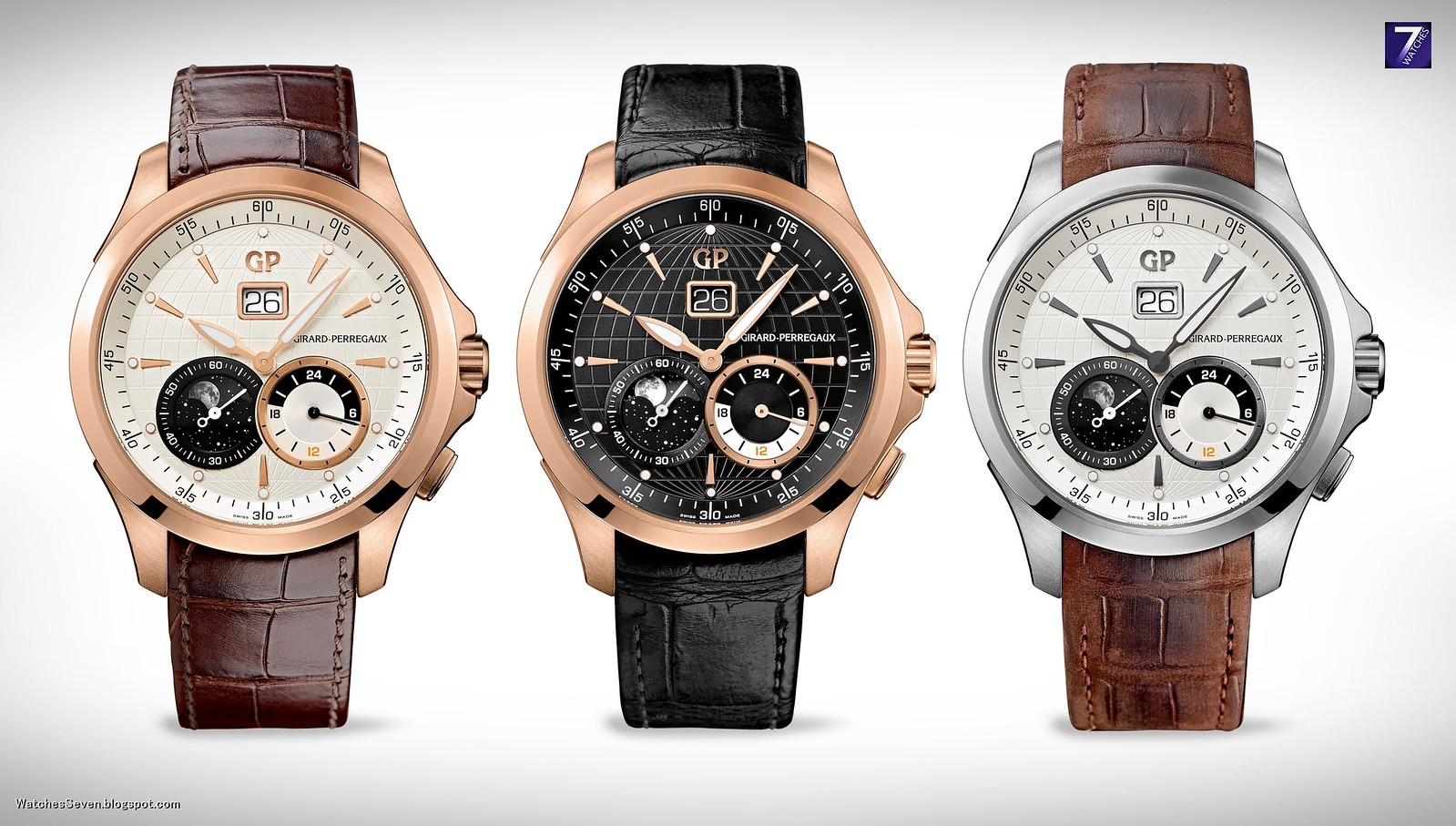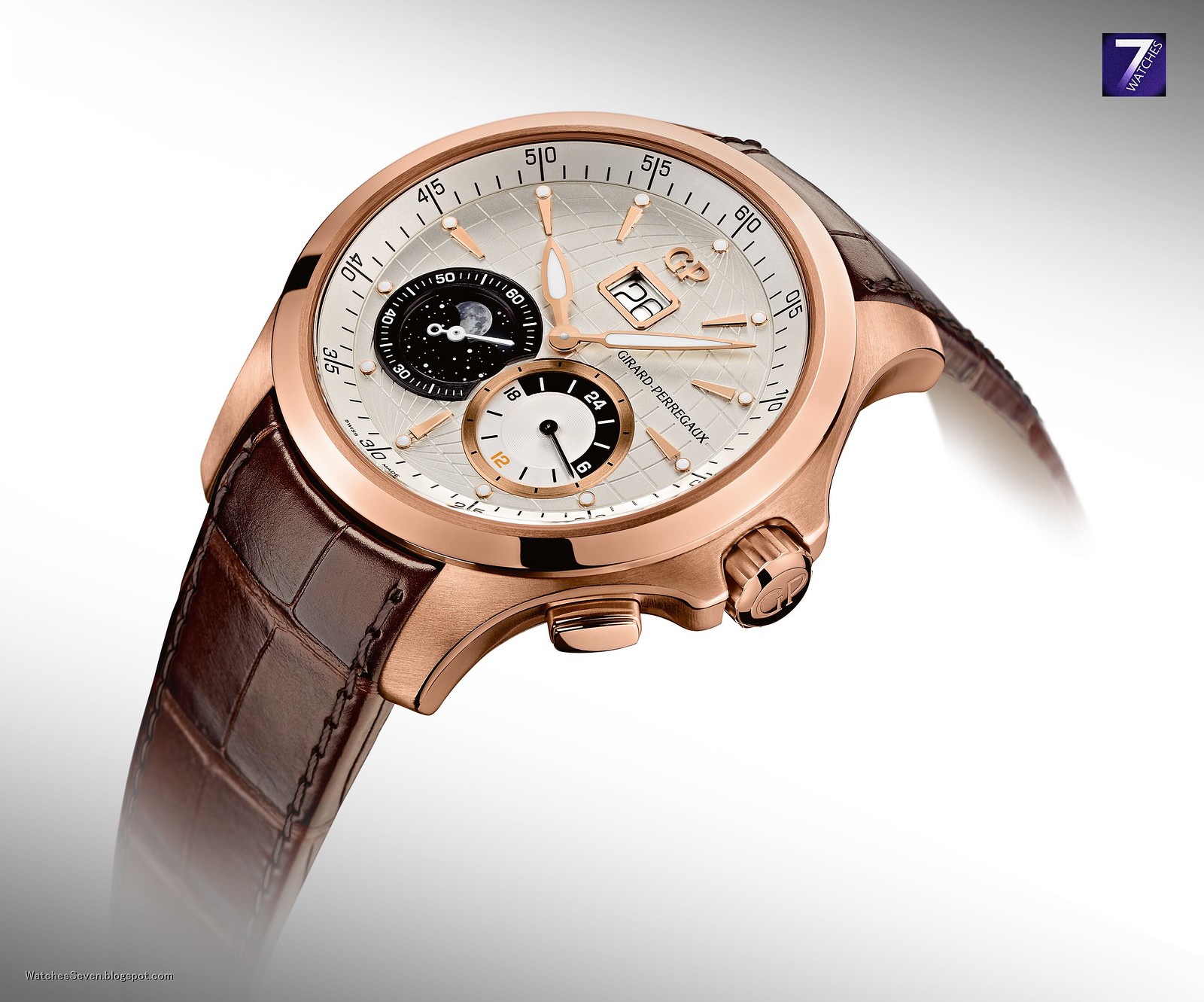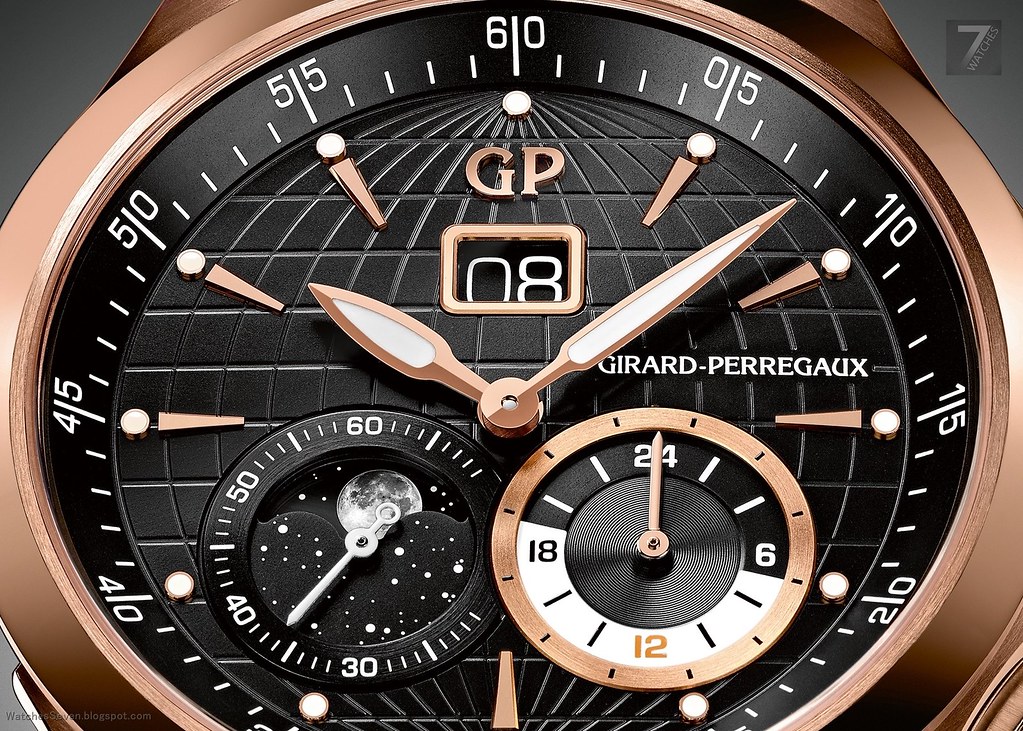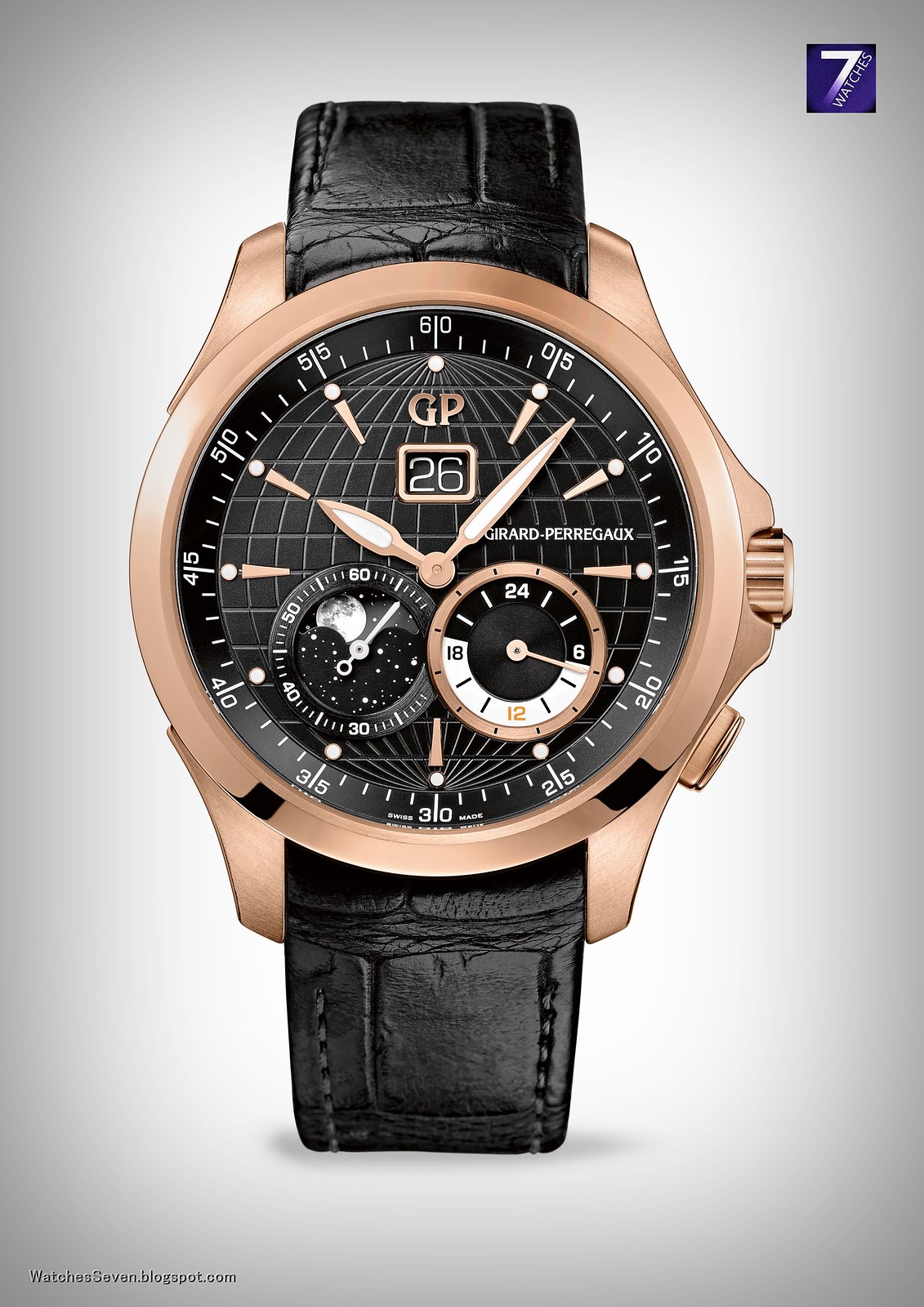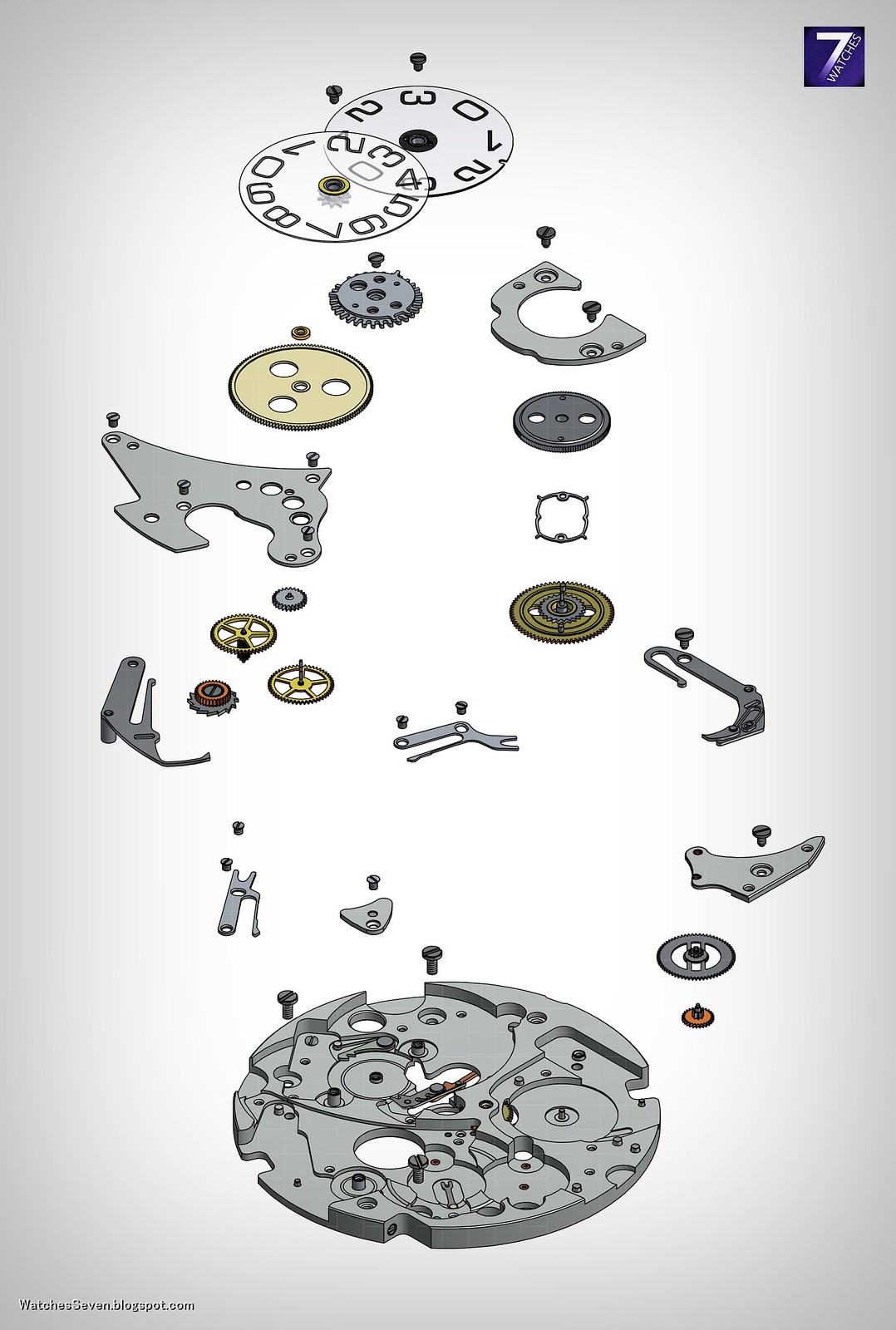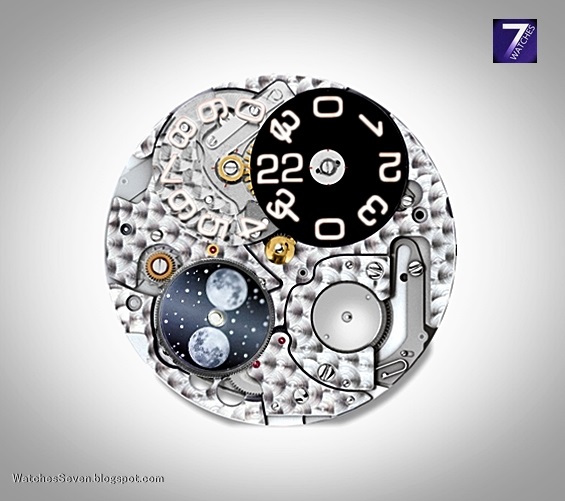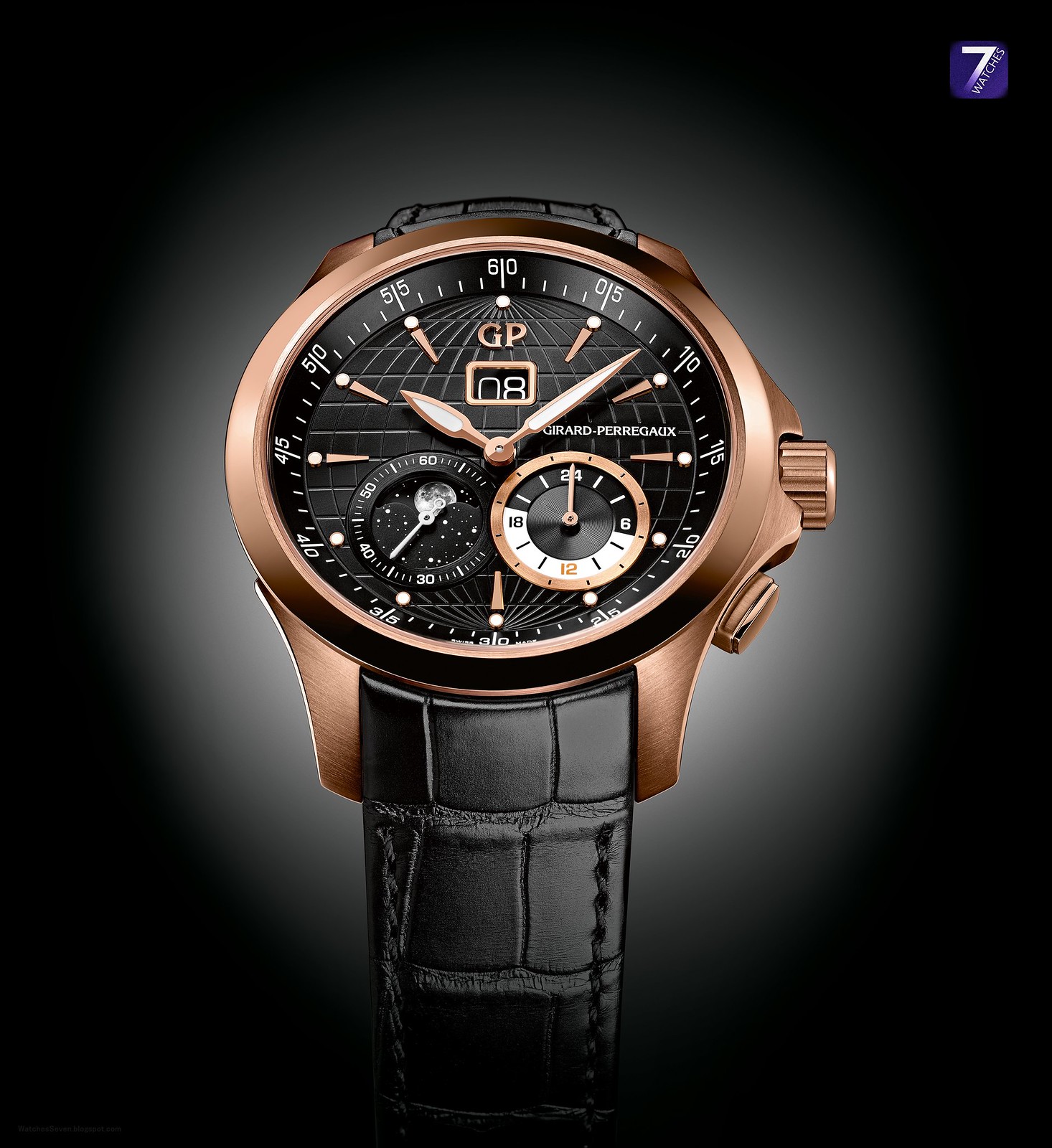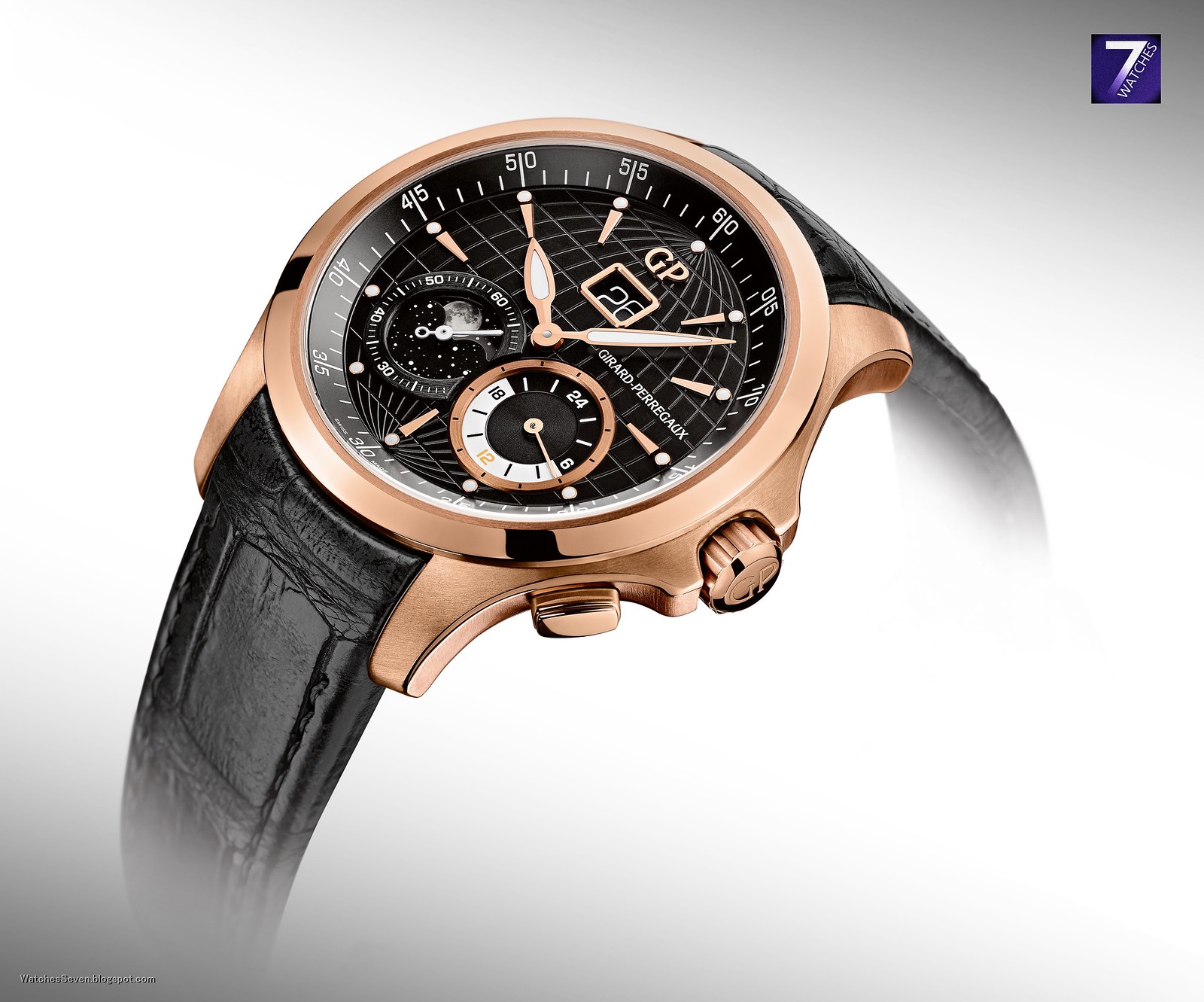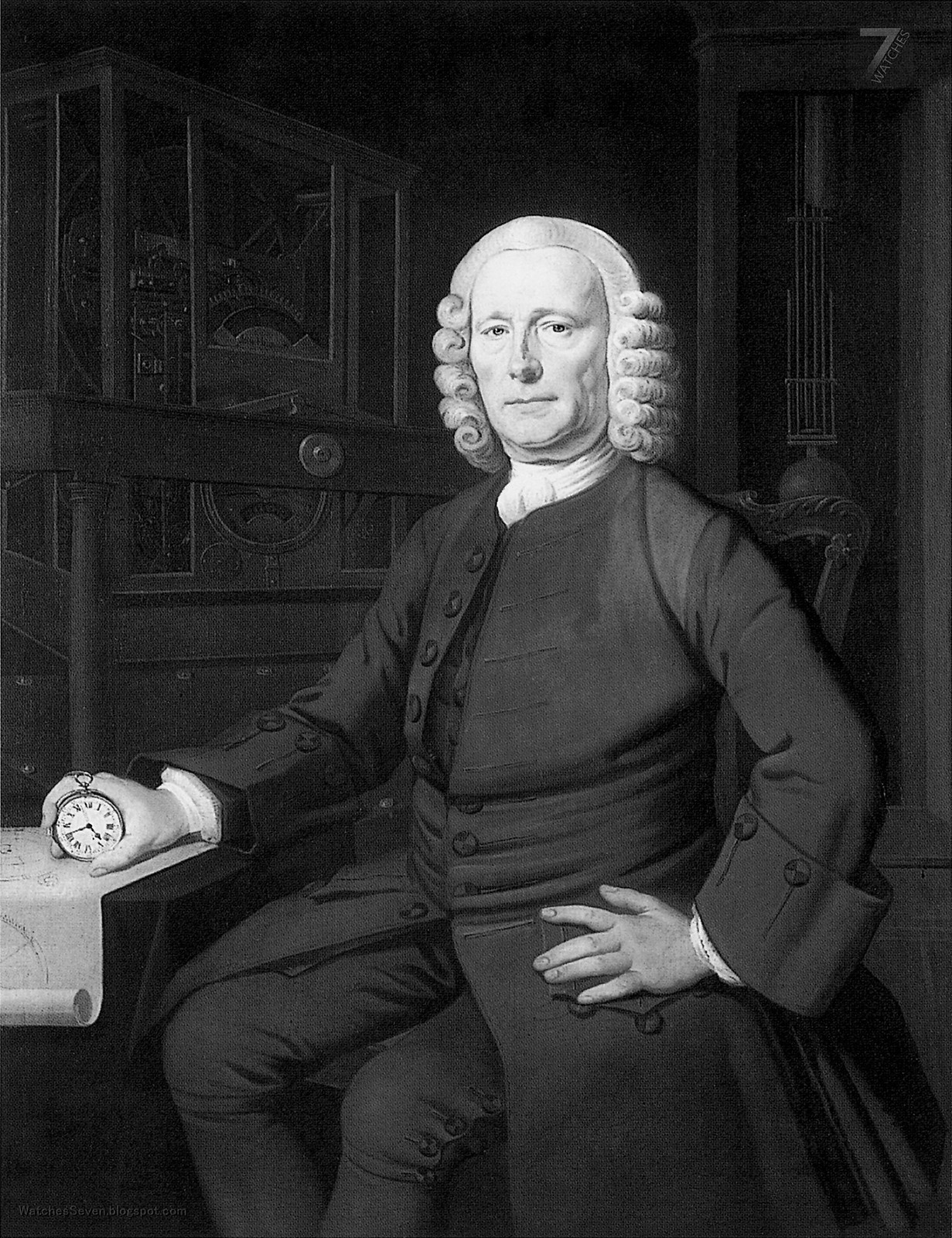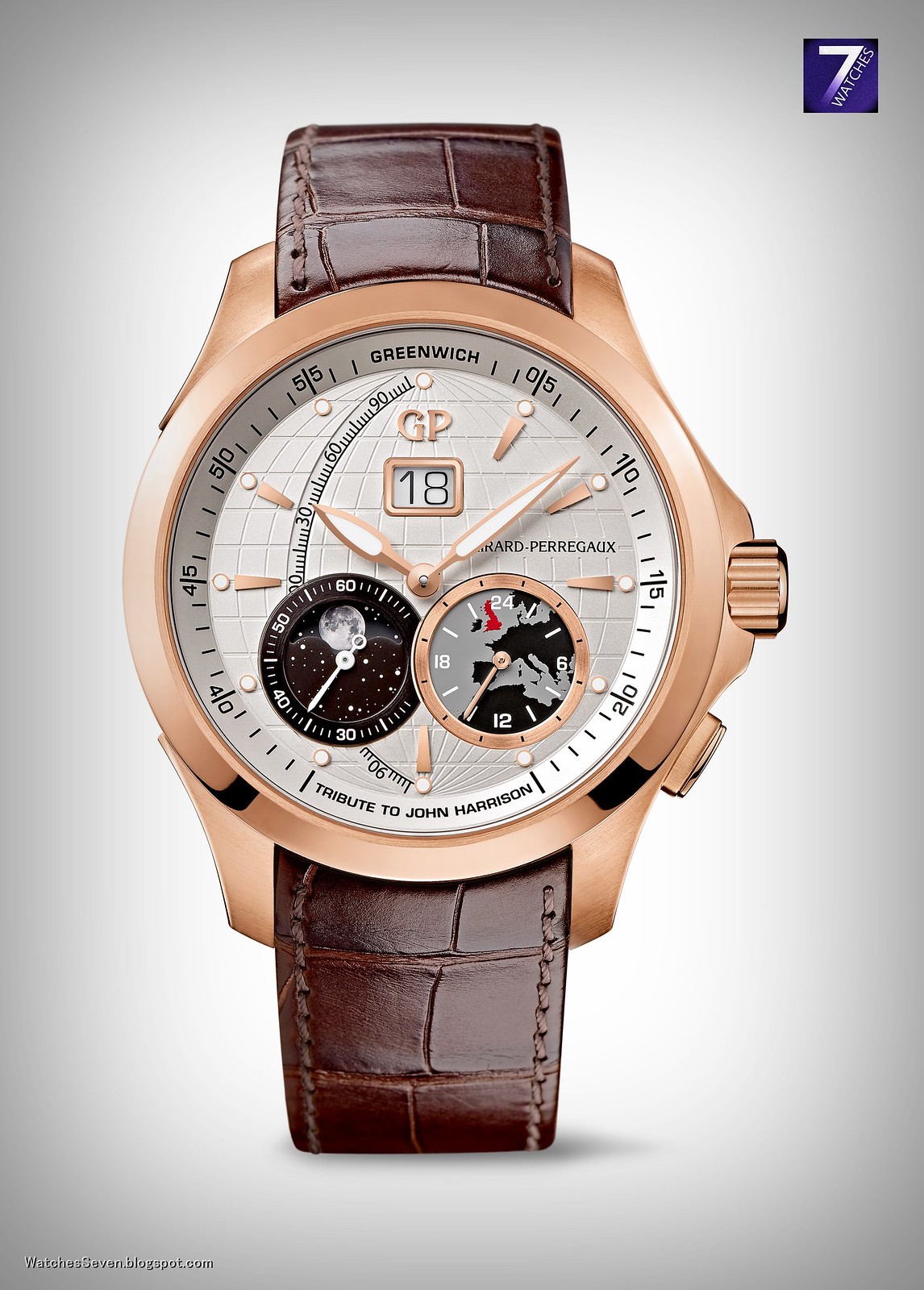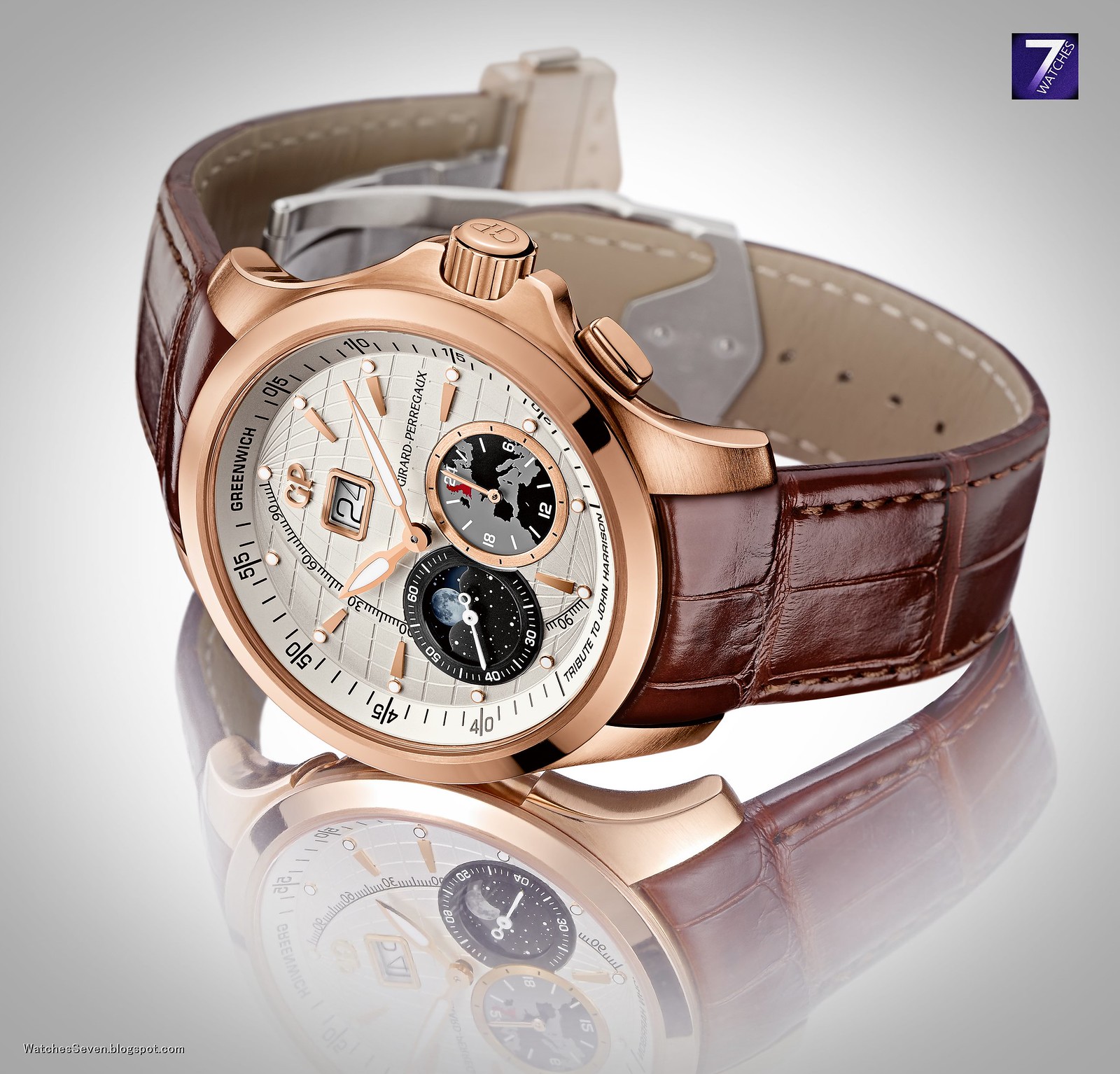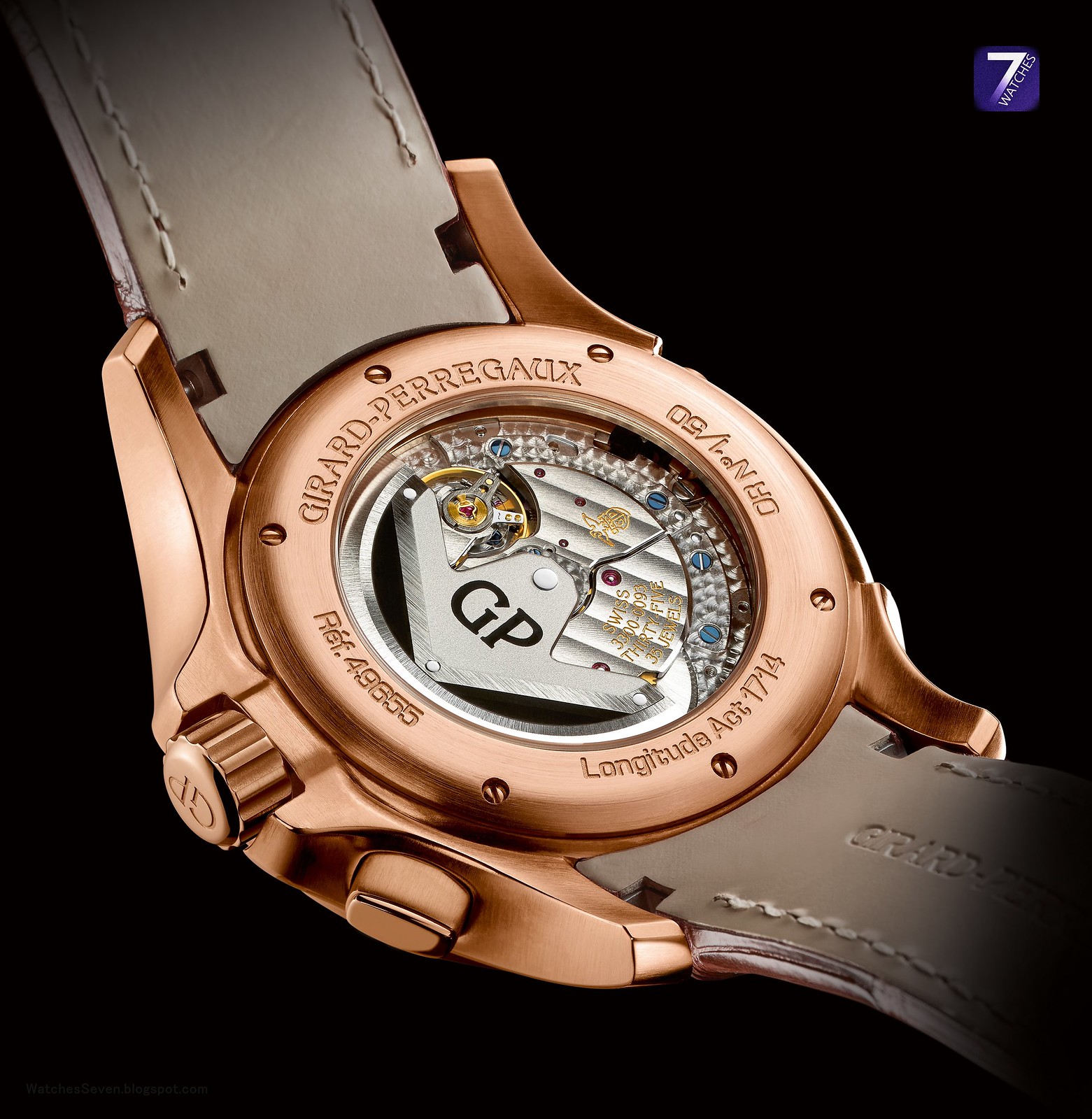GIRARD-PERREGAUX – TRAVELLER Large Date, Moon Phases & GMT & TRAVELLER Tribute to John Harrison Limited Edition NEW
The Traveller Large Date, Moon Phases & GMT model has been conceived by Swiss watchmaker Girard-Perregaux as the latest in a long line of watch creations specifically designed by the brand over the years with the international traveling public in mind. This high-performing timepiece is constructed especially to accompany the planet's globe-trotting citizens on the road to adventure. With its evocative name, its contemporary-sized 44 mm case available in steel, in pink gold or in a limited edition dedicated to John Harrison to mark the 300th anniversary of the Longitude Act, its role as an invitation to travel is clearly displayed for all to see.
Click on the mouse wheel to see the large size ... BIG FOTO
Long-distance travel
Conceived to meet the needs of long-distance travelers, the Traveller Large Date, Moon Phases & GMT watch aspires to be accepted into the lives of those who have chosen it, just like any other much-loved possession performing an essential function. Which explains why this new timepiece in the Traveller Collection is made to both to sit easily on the wrist and to catch the eye of watch connoisseurs in the kind of location where this model is most likely to be worn.
Click on the mouse wheel to see the large size ... BIG FOTO
An obvious choice for airport lounges, very much at home in the lobbies of grand international hotels and an invaluable companion for journeys across the planet, this watch is destined to be synchronized to local time wherever it is, since it is a timepiece that is perfectly attuned to its era. Urban by vocation and totally at ease in its home environment, all it needs is a simple invitation to go on a trip or attend a meeting – little matter if it's in a neighboring country or on the other side of the world – and all its huge potential and and ability to adapt soon make themselves felt.
Click on the mouse wheel to see the large size ... BIG FOTO
The art of detail
So as to ensure that the Traveller Large Date, Moon Phases & GMT offers the wearer maximum comfort, every last detail has been attended to, from the curve of its case band to the perfect alignment of its screwed-down crown. Thanks to its ideal dimensions, generous 44 mm diameter and a slim bezel combined with a deep flange, the case offers exceptional legibility. The date is handsomely displayed on the dial in an impressive aperture located at 12 o'clock.
Click on the mouse wheel to see the large size ... BIG FOTO
The information relating to the second time-zone are indicated in the counter situated between 4 and 5 o'clock, while the details concerning the moon phases are observed through the aperture opened into the permanent seconds counter. Since every detail counts in a model such as this, the precise pattern outlined on the dial, inspired by the Earth's interlocking meridians and parallels, gives the model an outstanding feeling of volume.
In addition to acting as a subliminal invitation to travel, these lines, merging into the dial's narrow indexes, help to draw the eye to the aperture in which the moon appears. The precision of its displays and its ultra-detailed graphic treatment combine to make this watch truly unique. Its stylish design gives this understated and atypical watch an air of unmistakable strength, while seducing even the most rational among us through the poetic attraction of our planet's natural satellite, the Moon.
Click on the mouse wheel to see the large size ... BIG FOTO
A benchmark caliber
Water-resistant at up to ten atmospheres (or a depth of approx. 100 meters), the satin-brushed and polished case in steel or 18K pink gold with a 44 mm diameter and a thickness of 12.10 mm protects from external contact a GP03300-0093 self-winding manufacture caliber.
Click on the mouse wheel to see the large size ... BIG FOTO
Viewed through the transparent case-back, the self-winding movement measuring 13½ lignes (equivalent to a diameter of 30.40 mm) reveals some of its components, including the oscillating weight inspired by the shape of the Girard-Perregaux tourbillon bridge, and shows the great care dedicated by the Manufacture to its finishes, all undertaken in its own workshops.
Delicate but robust, this top-of-the-range watch mechanism, equipped with 35 jewels and a 46-hour power reserve, beats at 28,000 vibrations per hour, to ensure the very highest accuracy in all situations. The Traveller Large Date, Moon Phases & GMT model is, by definition, an urban watch, the main role of which is dedicated to the theme of travel. It will seduce watch-lovers by its generous dimensions and its highly legible dial, the symmetry of which contributes to the model 's overall balance. Available on a large alligator-skin strap perfectly adjusted so as all the better to emphasize the thinness of the case design, this new model is attached to the wrist by means of a folding clasp so as to ensure it remains intact in all situations.
Click on the mouse wheel to see the large size ... BIG FOTO
Technical Details and Specific Features
The Large Date function:
The design patented by Girard-Perregaux displays the date without separating the two numerals that make up the figure. To achieve this result, the tens disk is opaque while the numerals representing the units are positioned on a transparent disk that is only 0.10 mm thick – the thickness of a piece of paper! The superimposing of these two disks means that the 30 or 31 days of the months can be displayed in an unusual format that is highly practical for all those who wish to read the date without needing to adjust the distance they hold the watch from their eyes. Not only that, but this clever system is linked to an instant date-change, which means that it changes in a fraction of a second (specifically, 15/1000ths of a second).
Click on the mouse wheel to see the large size ... BIG FOTO
The Moon Phase function:
Magical and dream-like, the indication of the moon’s phases found here is highly unusual since our satellite is not represented by a simple gold disk on a blue background, as is usually the case. Rather, it displays in miniature all the features of the real moon that we can observe in the sky above us on a clear night. To obtain this level of detail, the image of the heavenly body is metal-plated with a multiplicity of shades of gray on top of an extremely thin disk. This is what gives this representation its unique transparency and the impression of lightness that emanates from it. While remaining ultra-precise in functional terms, this moon is not linked to the conventional gear-train, but rather to the barrel. Thanks to its wheel with 135 indentations, this guarantees such a high degree of accuracy that it will only need to be readjusted by one day after a period of 122 years and 45 days! And since every detail counts, one of the delicate silvery stars symbolizing the night sky bears the Girard-Perregaux logo at its center, like a secret signature.
-----------------------------------------
Technical Specifications
Reference: 49655-52-131-BB6A Pink Gold Brown alligator Strap
Reference: 49655-11-132-BB6A Steel Brown alligator Strap
Reference: 49655-52-631-BB6A Pink Gold Black alligator Strap
Case:
- in pink gold
- in steel
Diameter : 44.00 mm
Crystal: anti-reflective sapphire
Dial:
Dial:
- off-white
- opaline silvered
- galvanic black
Water resistance: 100 meters (10 ATM)
Calibre:
Girard-Perregaux movement GP03300-0095
Mechanical, self-winding movement
Mechanical, self-winding movement
Caliber: 13 ’’’
Diameter: 30.40 mm (13 ½’’’)
Frequency: 28,800 vib/h - (4 hz)
Power reserve: min. 46 hours
Jewels: 35
Functions:
Functions: hour, minute, small second, large date, moon phaseDiameter: 30.40 mm (13 ½’’’)
Frequency: 28,800 vib/h - (4 hz)
Power reserve: min. 46 hours
Jewels: 35
Functions:
indicator, 24-hour 2nd time zone with day/night indicator
Strap:
Brown alligator strap
Black alligator Strap
Folding buckle
Brown alligator strap
Black alligator Strap
Folding buckle
The Traveller John Harrison Limited Series watch (restricted to 50 pieces)
Click on the mouse wheel to see the large size ... BIG FOTO
2014 marks the tercentenary of the passing of the Longitude Act by the British Parliament. By this official Act of Parliament, adopted in 1714 and motivated notably by a terrible shipwreck near the Isles of Scilly off the south-west coast of England that had destroyed several Royal Navy vessels and led to hundreds of sailors losing their lives, the British Government set up the Board of Longitude, an organism intended to judge the feasibility of methods proposed to measure a ship's longitude at sea.
Click on the mouse wheel to see the large size ... BIG FOTO
The inventor of the most effective solution, which would guarantee that a sailing ship could reach its destination after a six weeks' voyage to the West Indies (an expression used at the time to refer to both the Americas and the Caribbean) with an accuracy of at least 30 nautical miles, was to be awarded a prize of twenty thousand pounds sterling – a considerable sum for the day.
Click on the mouse wheel to see the large size ... BIG FOTO
Over a number of years the Board, presided over by eminent scientists and figures of the period, passed judgment on a range of proposals, many of which were so eccentric or outrageous that the members of the institution ended up by doubting whether it would ever be possible to measure longitude at sea other than by the astronomical methods being developed at the time.
Click on the mouse wheel to see the large size ... BIG FOTO
This, however, was to reckon without John Harrison, an English carpenter and self-taught clockmaker born on March 24, 1693 at Foulby in Yorkshire. In 1735 – fully 21 years after the passing of the Longitude Act – this brilliant visionary presented the first instrument that was truly worthy of interest and had a real chance of providing a solution to the thorny problem of the calculation of a ship's longitude. Harrison was to become known as the most brilliant clockmaker of his day. When, however, he presented his first marine clock (known by the designation H-1), he could not suspect that his invention would not only prove that longitude could indeed be calculated by the use at sea of marine clocks, marine chronometers and subsequently by specially devised watches, but that his discovery would also spur on the clockmaking profession and encourage his contemporaries and competitors to throw themselves into the race to achieve truly accurate timekeeping. Thus, despite his disappointment at not winning the £20,000 prize for his first model, he presented a second version (H-2) in 1739, to be followed by H-3 nearly twenty years later. Finally, in October 1759, he unveiled his H-4, a hyper-accurate pocket watch. The Board, meanwhile, had imposed new conditions, including the requirement that all samples of his invention should be tested. John Harrison then proceeded to work on a fifth great timepiece, H-5, which produced outstanding results. In his old age Harrison was finally accorded a monetary reward of £8,750 by Parliament, in 1773.
Click on the mouse wheel to see the large size ... BIG FOTO
By commemorating the tercentenary of the Longitude Act, the Girard-Perregaux Manufacture, and with it the whole of the contemporary watch industry, pays tribute to John Harrison, that combative and methodical man who through his untiring efforts demonstrated that it would become possible, and in the end even easy, to measure longitude by means of accurate timepieces. This clockmaker's invention has not only saved the lives of countless sailors over the centuries, but also enabled seafarers to diverge from traditional sea-routes, infested with pirates, to forge more adventurous passages across the ocean waves. Thanks to the daily calculation of latitude and longitude, they were henceforth able to determine their position with precision and thus set out to explore and conquer hitherto unknown territories. This was precisely what Captain James Cook did when he explored the Pacific from 1772 to 1774, carrying on board his vessel a replica of Harrison's H4 Sea Watch made by the English clockmaker Larcum Kendall.
Click on the mouse wheel to see the large size ... BIG FOTO
To pay tribute to the visionary genius of John Harrison, an inventor who symbolizes all the huge progress made in clockmaking during the Age of Enlightenment, the Girard-Perregaux Manufacture proposes for this tercentenary year of the the Traveller Large Date, Moon Phase & GMT Tribute to John Harrison watch, in a limited-series edition restricted to 50 pieces in 18K pink gold.
This 44 mm-diameter watch worn on an alligator-skin strap, equipped with functions of great utility to travelers, is dedicated to the father of modern timekeeping and the inventor of the method of calculating longitude at sea. To differentiate this rare timepiece from large-scale production models, Girard-Perregaux, whose travelers' watches have long been a house specialty, has decided to create a special dial for the occasion and a case-back carrying the words "Tribute to John Harrison".
This dial has been elaborated so as to recall John Harrison's contribution to the science. One of the meridians engraved onto the dial is highlighted thanks to an added applied graduation. This representation is designed to illustrate the original prime meridian, corresponding to that of Greenwich in England. It was this meridian that was used by Harrison to define a standard reference time and this time that the clocks and watches he invented would be required to record as accurately as possible. In addition to this, and to highlight even further the geographical dimension of the model, Girard-Perregaux has decided to insert in the second time-zone counter a map of Western Europe, in black on an anthracite-gray background. Vivid red is used to mark out Great Britain, John Harrison's mother country, which, thanks to this clockmaker's invention and to the might of its Empire, imposed the Greenwich Meridian as the standard time reference for the entire world.
Click on the mouse wheel to see the large size ... BIG FOTO
As an oblique side-reference it will nevertheless be noted that the original meridian here passes through the moon phase window, the realistic representation of which has been achieved by the delicate process of metal-plating a diminutive disk. Its presence here is surely no accident, since a footnote to history relates that John Harrison was engaged in a dispute with the Astronomer Royal, Nevil Maskelyne. The latter, as a member of the Board of Longitude, was for his part keen to promote the calculation of longitude by astronomical techniques, and in particular by the "Method of Lunar Distances", also called at the time the method of the "Lunars".
-----------------------------------------
Technical Specifications
Reference: 49655-52-133-BBBA Pink Gold Brown alligator Strap 50-piece limited edition.
Case:
in pink gold
in pink gold
Dimensions:
Diameter : 44.00 mm
Crystal: anti-reflective sapphire
Dial:
Dial:
off-white
Case-back: Sapphire crystal, secured by 6 screws
Water resistance: 100 meters (10 ATM)
Case-back: Sapphire crystal, secured by 6 screws
Water resistance: 100 meters (10 ATM)
Calibre:
Girard-Perregaux movement GP03300-0093
Girard-Perregaux movement GP03300-0093
Mechanical, self-winding movement
Caliber: 13 ’’’
Diameter: 30.40 mm (13 ½’’’)
Frequency: 28,800 vib/h - (4 hz)
Power reserve: min. 46 hours
Jewels: 35
Functions:
hour, minute, small second, large date, moon phaseDiameter: 30.40 mm (13 ½’’’)
Frequency: 28,800 vib/h - (4 hz)
Power reserve: min. 46 hours
Jewels: 35
Functions:
indicator, 24-hour 2nd time zone
Strap:
Brown alligator strap
Folding buckle
Brown alligator strap
Folding buckle
---------------------------------------
-------------------------------------------------------
---------------------------------------
Following the trail of history
Clockmakers and watchmakers have always been keen to produce timepieces that are useful for any occasion. Jean-François Bautte, the founder of the watchmaking firm that was to be absorbed into Girard-Perregaux in the early 20th century (in 1906, to be precise), was a precursor in the field of timekeeping for travelers. By as early as 1820 he was proposing a pocket watch equipped with a caliber that could display two different, independently set times on its enamel dial. Later, in 1860, with the industrial revolution at its height and keen to respond to the desire of the new captains of industry to embrace the world, Girard-Perregaux developed a pocket watch displaying the local time in five major world cities: San Francisco, Montevideo, Rio de Janeiro, New York and Paris.
Click on the mouse wheel to see the large size ... BIG FOTO
However it was only with the onset of the first transcontinental railroads that industrialists and scientists started to favor the idea of dividing up the globe into uniform time zones so as to be able to coordinate the timetables of the world's railroad networks. It was the Canadian Sir Sandford Fleming who proposed in 1876 that the world should be divided into 24 time zones each of 15º. While an interesting idea, this proposal was only partially adopted after the Washington Conference of 1884, which defined a universal 24-hour time system starting at midnight at the meridian the most widely used at the time: Greenwich. Nevertheless, this division was only really accepted throughout the world from the early 20th century onward. By this time, watches equipped with the capacity to display two or more times on their dials were enjoying enormous success as a result of the speeding up of methods of transport and the rapid spread of the telephone. Influenced by this universalizing trend, Geneva watchmaker Louis Cottier developed an ingenious mechanism for displaying the time in the 24 main time zones in relation to the time in the original country or time zone selected. However, it was only from the mid-1950s onward (as a result of the generalization of air travel and of international communications) that the general public truly became acquainted with a coherent system for the 24-hour displaying of a second time zone, known under the acronym of GMT (for Greenwich Mean Time). Since then this indication has formed part of the habits most appreciated by travelers the world over.
Clockmakers and watchmakers have always been keen to produce timepieces that are useful for any occasion. Jean-François Bautte, the founder of the watchmaking firm that was to be absorbed into Girard-Perregaux in the early 20th century (in 1906, to be precise), was a precursor in the field of timekeeping for travelers. By as early as 1820 he was proposing a pocket watch equipped with a caliber that could display two different, independently set times on its enamel dial. Later, in 1860, with the industrial revolution at its height and keen to respond to the desire of the new captains of industry to embrace the world, Girard-Perregaux developed a pocket watch displaying the local time in five major world cities: San Francisco, Montevideo, Rio de Janeiro, New York and Paris.
Click on the mouse wheel to see the large size ... BIG FOTO
However it was only with the onset of the first transcontinental railroads that industrialists and scientists started to favor the idea of dividing up the globe into uniform time zones so as to be able to coordinate the timetables of the world's railroad networks. It was the Canadian Sir Sandford Fleming who proposed in 1876 that the world should be divided into 24 time zones each of 15º. While an interesting idea, this proposal was only partially adopted after the Washington Conference of 1884, which defined a universal 24-hour time system starting at midnight at the meridian the most widely used at the time: Greenwich. Nevertheless, this division was only really accepted throughout the world from the early 20th century onward. By this time, watches equipped with the capacity to display two or more times on their dials were enjoying enormous success as a result of the speeding up of methods of transport and the rapid spread of the telephone. Influenced by this universalizing trend, Geneva watchmaker Louis Cottier developed an ingenious mechanism for displaying the time in the 24 main time zones in relation to the time in the original country or time zone selected. However, it was only from the mid-1950s onward (as a result of the generalization of air travel and of international communications) that the general public truly became acquainted with a coherent system for the 24-hour displaying of a second time zone, known under the acronym of GMT (for Greenwich Mean Time). Since then this indication has formed part of the habits most appreciated by travelers the world over.
www.facebook.com - Girard Perregaux
------------------------------------------------------------------------------
www.Girard-Perregaux.com


